

12th August 2025 (13 Topics)
Mains Issues
Context:
The Government has reported record enrolment under PMFBY in 2024–25 with 4.19 crore farmers covered and ?1.83 lakh crore paid in claims since its launch in 2016.
From Crop Loss Protection to Technology-Driven Agricultural Security
Pradhan Mantri FasalBima Yojana (PMFBY)
- Launch and Objective: Launched on 18 February 2016 to provide affordable, simple, and comprehensive crop insurance against non-preventable natural risks.
- Coverage Scope: Entire crop cycle from pre-sowing to post-harvest, including storage losses due to notified calamities.
- Core Principle: “One Nation, One Crop, One Premium” ensuring fairness and uniformity.
Achievements and Outreach
- Farmer Enrolment: Increased 32% from 3.17 crore (2022–23) to 4.19 crore (2024–25), highest since inception.
- Claims Paid: ?1.83 lakh crore to 22.67 crore farmers since 2016.
- Non-Loanee Farmer Inclusion: Applications grew from 20 lakh (2014–15) to 522 lakh (2024–25), reflecting trust beyond credit-linked enrolment.
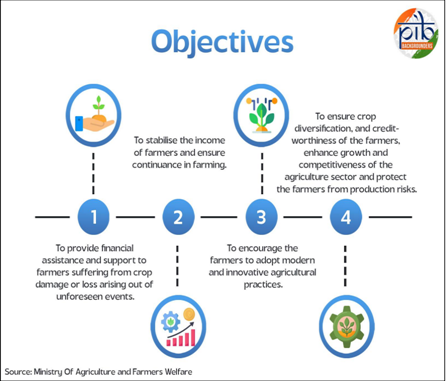
Scheme Benefits
- Affordable Premiums: 2% for Kharif food/oilseeds, 1.5% for Rabi food/oilseeds, 5% for annual commercial/horticulture crops; balance shared between Centre & States (50:50, with special ratios for NE and Himalayan States).
- Comprehensive Risk Coverage: Yield losses, prevented sowing (up to 25% of sum insured), post-harvest losses (up to 14 days), and localised calamities.
- Timely Compensation: Target to process claims within two months post-harvest.
Technology-Driven Enhancements
- National Crop Insurance Portal (NCIP): For online enrolment, monitoring, and direct claim transfers.
- Digi Claim Module: Automated 12% penalty on delayed claims (from Kharif 2024).
- YES-TECH: Remote sensing-based yield estimation for paddy, wheat (2023), soybean (2024).
- WINDS: Expands automatic weather stations and rain gauges fivefold for hyper-local weather data integration.
Governance and Implementation Measures
- ESCROW Accounts: States mandated to deposit premium share in advance (from Kharif 2025).
- Awareness Drives: “Crop Insurance Week”, “FasalBimaPathshala”, and “Meri Policy Mere Haath”.
- Grievance Redressal: KRPH Portal and Helpline (14447) for ticket-based complaint tracking.
Significance
- Economic Security for Farmers: Reduces vulnerability to crop failures, preventing indebtedness.
- Inclusivity: Sharp rise in non-loanee farmer enrolment indicates outreach beyond institutional credit beneficiaries.
- Technology Integration: Enhances transparency and accuracy in crop loss estimation, reducing disputes and delays.
Challenges
- Premium Payment Delays by States: Often hinder timely claim settlement.
- Awareness Gaps: Small and marginal farmers may still lack clarity on procedures and entitlements.
- Implementation Variability: Differences in State-level execution impact uniform benefits.
Way Forward
- Strengthen Awareness Campaigns: Use Panchayati Raj platforms for deeper rural penetration.
- Faster Claim Settlement Mechanism: Leverage AI-driven loss assessment to reduce claim processing time further.
- Expand Parametric Insurance Models: Link payouts more directly to measurable weather or yield parameters for quicker disbursement.
- Improve Data Integration: Seamless linking of land records, weather, and yield data for accurate risk profiling.


Prelims Articles
Context:
The Cooperative Election Authority (CEA) held its first consultative meeting with State Cooperative Election Authorities in New Delhi to strengthen transparency and fairness in cooperative body elections.
Cooperative Election Authority (CEA)
- Constitution: Established under Section 45 of the Multi-State Cooperative Societies Act, 2002, as amended in 2023.
- Notification Date: 11 March 2024.
- Mandate: Conduct elections to Multi-State Cooperative Societies (MSCS) in a free, fair, and transparent manner.
- Performance: Since March 2024, conducted 159 elections; 69 more elections are in process.
Key Functions Discussed in Meeting:
- Framing of Code of Conduct for contesting candidates in MSCS elections.
- Upper Limit on Candidate Expenditure: Proposed expenditure cap to ensure level playing field.
- Publication of Handbook for Returning Officers to standardise election procedures.
- Election of Delegates: From member cooperative societies to national cooperative societies.
- Use of Technology: Proposal to introduce Electronic Voting Machines (EVMs) in cooperative elections.
- Operational Measures: Discussion on share capital rules, candidate symbols, and use of indelible ink.
Significance:
- Enhances democratic governance in the cooperative sector.
- Strengthens accountability in a sector crucial for rural credit, agriculture, and allied activities.
- Aligns with International Year of Cooperatives 2025, highlighting India’s commitment to cooperative sector reforms.


Prelims Articles
Context:
The Ministry of Jal Shakti outlined the criteria and implementation progress of Atal Bhujal Yojana (ABY) for water-stressed Gram Panchayats across seven states.
Atal Bhujal Yojana (ABY)
- Name: Atal Bhujal Yojana (ABY) – Central Sector Scheme.
- Launch Objective: Promote community-led participatory groundwater management focusing on both demand- and supply-side interventions.
- Coverage: Implemented in 8,203 priority Gram Panchayats across 7 states – Haryana, Gujarat, Karnataka, Madhya Pradesh, Maharashtra, Rajasthan, and Uttar Pradesh (pilot basis).
- Selection Criteria:
- Degree of groundwater exploitation and degradation.
- Existing legal and regulatory mechanisms.
- Institutional readiness and prior experience in groundwater management.
- Willingness to participate.
- Final selection by respective state governments for administrative feasibility.
Integration with Other Programmes
- Jal Shakti Abhiyan (2019 onwards):Rainwater harvesting, conservation, and recharge activities with community participation; >700 Jal Shakti Kendras set up.
- Jal Sanchay Jan Bhagidari: Low-cost local artificial recharge structures, borewell recharge shafts.
- MGNREGS:Water conservation works like farm ponds, check dams, percolation tanks, contour trenches; ~60% of resources for natural resource management.
- CGWB Programmes:Public Interaction Programmes (PIP) and Mass Awareness Programmes (MAP) on groundwater recharge.
Key Achievements under ABY
- Data Management: Groundwater data measurement and public disclosure in all GPs through physical and digital means.
- Planning: Community-led Water Budgets (WBs) and Water Security Plans (WSPs) prepared and updated annually.
- Capacity Building: Over 25 lakh GP-level trainings plus higher-level capacity-building workshops.
- Infrastructure: Installation of piezometers, DWLRs, and rain gauges in almost all GPs.
- Water Conservation Structures: ~81,700 structures (check dams, ponds, recharge shafts) built/renovated.
- Efficient Practices: ~9 lakh hectares under efficient water-use practices (drip/sprinkler irrigation, mulching, crop diversification).


Prelims Articles
Context:
The Lok Sabha has passed the Income Tax (No. 2) Bill, 2025, replacing the Income Tax Act, 1961, with a shorter and more simplified law, while expanding powers of tax officials in search operations.
Income Tax Bill, 2025
Objective of the Bill
- Simplify, rationalise, and shorten the Income Tax Act, 1961.
- Incorporates recommendations of the Select Committee chaired by Baijayant Panda.
Key features:
- Volume Reduction: Sections cut from 819 ? 536; chapters from 47 ? 23; removal of 283 sections and 24 chapters.
- Language Simplification: Introduces “tax year” instead of ‘financial year’ and ‘assessment year’.
- Clear Tax Framework: Defines taxable income, compliance rules, and restrictions on certain activities.
- Virtual Digital Assets: Statutory definition for cryptocurrencies, NFTs, etc., with specific taxation provisions.
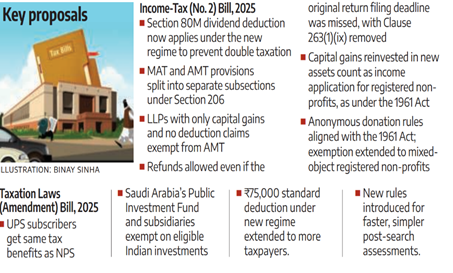
- Tax Slabs: No change; existing slabs and rebates retained for continuity.
- Redundant Provisions Removed: Outdated laws like Fringe Benefit Tax
- Taxpayer’s Charter: Lists rights and responsibilities to enhance transparency.
- ADR Mechanism: Provides alternate dispute resolution for quicker settlements.
- Presentation: Use of 57 tables and 46 formulae for clarity.
- Policy Impact: Aligns with Ease of Doing Business, supports digital economy taxation, and maintains revenue stability.


Prelims Articles
Context:
The Ministry of Environment, Forest and Climate Change (MoEF&CC) reported on the implementation of the E-Waste (Management) Rules, 2022 and CPCB’s measures to strengthen e-waste regulation and enforcement in FY 2023–25.
Legal Framework
- E-Waste (Management) Rules, 2022: Notified in November 2022, in force since 1 April 2023.
- Replaces the E-Waste (Management) Rules, 2016.
- Regulates 106 Electrical and Electronic Equipment (EEE) listed in Schedule-I (includes mobile phones, computers, UPS systems).
- Mandates Extended Producer Responsibility (EPR) for producers, manufacturers, refurbishers, and recyclers, requiring registration on CPCB’s E-Waste EPR Portal.
Battery Waste Management Rules, 2022
- Covers all battery types (EV, portable, automotive, industrial).
- Prohibits disposal of waste batteries in landfills.
- Prescribes EPR targets for collection, recycling, or refurbishment.
- CPCB has issued SOPs for lead-acid battery recycling and hazardous fluid disposal.
Key CPCB Measures
- Online EPR Portal: For registration, tracking, and exchange of EPR certificates.
- Guidelines: On scientific and environmentally sound recycling, including machinery and pollution control norms.
- Action Plan Implementation: SPCBs/PCCs to conduct drives against informal sector operations, facilitate their formalisation, and submit quarterly progress reports.
- Verification and Audit: Random inspections and periodic audits to ensure compliance.
- Environmental Compensation (EC) Guidelines: For levying penalties on violators.
Significance
- Strengthens India’s transition to a circular economy.
- Aims to formalise e-waste recycling, reduce environmental hazards, and ensure resource recovery.
- Enhances traceability and compliance through digital monitoring.


Prelims Articles
Context:
The Ministry of Environment, Forest and Climate Change (MoEF&CC) celebrate World Elephant Day 2025 in Coimbatore, Tamil Nadu, with a special focus on human-elephant conflict mitigation and public awareness.
World Elephant Day
- Observed annually on 12 August to raise awareness about elephant conservation.
- India holds ~60% of the global wild elephant population.
- Elephants are designated National Heritage Animal of India.
India’s Elephant Conservation Framework
- 33 Elephant Reserves across India.
- 150 identified Elephant Corridors (as per 2023 Report on Elephant Corridors in India).
- Protected under Schedule I of the Wildlife Protection Act, 1972.
- Covered under Project Elephant (launched in 1992) for habitat protection, corridor management, and conflict mitigation.


Prelims Articles
Context:
Smooth-coated otters will return to the Delhi Zoo after a 20-year absence, as part of an animal exchange program with the Surat Zoo.
Taxonomy & Conservation Status
- Scientific Name:Lutrogaleperspicillata
- Genus:Lutrogale – the only extant (living) representative.
- IUCN Red List Status: Vulnerable (VU) due to habitat loss, poaching, and depletion of prey.
- CITES Listing: Appendix II – regulated trade.
- Indian Wildlife (Protection) Act, 1972: Schedule I – highest legal protection in India.
Distribution
- Widely found in southern Asia, from India eastwards through Southeast Asia.
- Isolated population in the marshes of Iraq.
- In India – found in the Indus, Ganga, and Brahmaputra basins, coastal areas, and certain protected wetlands.
Habitat Preferences
- Inhabits lowlands, coastal mangroves, peat swamp forests, freshwater wetlands, and large forested rivers.
- Adaptable to rice paddies and man-made wetlands.
- Builds burrows near water with underwater entrances and chambers above high-water lines.
Physical Characteristics
- Largest otter species in Southeast Asia.
- Adult weight: 7–11 kg; length: up to 1.3 m.
- Fur: Smooth, short, with dense underfur and water-repellent guard hairs.
- Color: Light to dark brown dorsally; pale brown to gray ventrally.
Behaviour & Ecology
- Strong swimmers; adapted for both aquatic and terrestrial movement.
- Can travel long distances overland in search of suitable habitat.
- Social species – hunts in groups.
- Hunting often in V-formation when swimming upstream to catch fish.
- Diet: Primarily fish, but also crabs, amphibians, and small aquatic animals.
Threats
- Habitat loss due to wetland drainage, dam construction, and conversion to agriculture.
- Poaching for fur and pet trade.
- Decline in prey species due to overfishing and pollution.
- Human–wildlife conflict in aquaculture and fishing areas.
Conservation Measures
- Legal protection under national and international laws.
- Conservation in protected areas like Kaziranga National Park, Sundarbans, and Chilika Lake.
- Awareness campaigns to reduce poaching and promote coexistence with fishing communities.
- Wetland restoration projects to secure habitats.

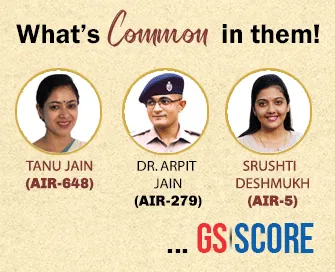
Prelims Articles
Context:
Scientists have reported that the Perito Moreno Glacier, historically stable for decades, has been thinning at a sharply accelerated rate since 2019, raising concerns of irreversible changes.
Perito Moreno Glacier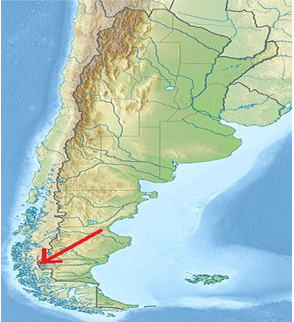
- Location: Situated in Los Glaciares National Park, a UNESCO World Heritage Site, Argentina.
- Known for its stability despite global glacier retreat trends.
- It is a tidewater glacier with a snout that periodically advances and retreats slightly, but has remained largely balanced in mass over decades.
Current Threats Identified
- Since 2019, thinning rates have sharply increased.
- Radar mapping in 2024 revealed deep bedrock ridges that help hold the glacier in place; thinning could destabilize this balance.
- If bedrock no longer anchors ice, the glacier could start floating, accelerating calving and retreat.
Implications of Destabilization
- Potential for irreversible retreat, similar to other rapidly declining glaciers.
- Loss of glacier mass would contribute to sea level rise.
- Glacial retreat could disrupt local ecosystems and tourism.
- Increased freshwater input to oceans can impact global ocean circulation.


Prelims Articles
Context:
A new multinational study has identified envelope dimer epitope (EDE)-like antibodies as critical determinants of cross-serotype protection against dengue virus, paving the way for improved vaccine design.
About Dengue Virus (DENV)
- Caused by four antigenically distinct serotypes (DENV-1 to DENV-4).
- Transmitted by Aedes aegypti and Aedes albopictus
- Most common vector-borne viral disease globally; 50% of world’s population at risk.
Immunity and Antibody-Dependent Enhancement (ADE)
- Primary infection: Produces antibodies that may not neutralise other serotypes effectively; increases risk of severe disease on secondary infection.
- ADE occurs when non-neutralising antibodies facilitate viral entry into immune cells, worsening infection.
- Secondary immunity after exposure to ?2 serotypes provides true cross-protection.
Envelope Dimer Epitope-like Antibodies
- Target quaternary epitope on paired envelope (E) proteins of DENV.
- Strongly associated with broad, cross-reactive immunity across all four serotypes.
- Highly prevalent (81.8–90.1%) in individuals with secondary immunity; rare (4–12%) in primary immunity cases.
- Correlate with reduced risk of symptomatic dengue, hospitalisation, and severe disease; less effective in preventing infection per se.
- Explain 42–65% of protective effect of mature virus-neutralising antibodies and 41–75% of E protein-binding antibodies.

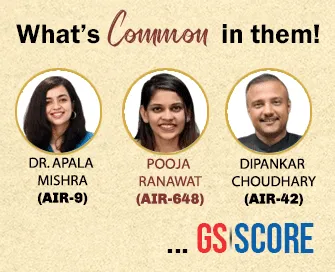
Prelims Articles
Context:
Reports indicate NASA was asked to prepare to shut down the Orbiting Carbon Observatory (OCO-2 and OCO-3) satellites that provide high-precision, space-based CO? and plant-health data.
What are the OCO missions?
- The Orbiting Carbon Observatory (OCO) family are dedicated Earth-observation missions.
- Designed to measure atmospheric carbon dioxide (CO?) with high precision.
- Objective: Locate sources and sinks of CO? globally.
Key Mission History and Platforms
- OCO-1 (2009): Failed to reach orbit due to launch vehicle fairing malfunction.
- OCO-2 (2014): Launched into a sun-synchronous polar orbit, providing precise global CO? maps.
- OCO-3 (2019): Mounted on the International Space Station (ISS) to complement OCO-2 by observing at different times of day.
Measurements and Importance
- Measures column CO? and vegetation “glow” (photosynthetic activity).
- Applications:
- Tracking global carbon fluxes (sources/sinks).
- Improving greenhouse-gas inventories at national & global levels.
- Creating high-resolution plant productivity maps for agriculture & drought monitoring.
- Enhanced understanding of CO? accumulation rates and mitigation priorities.
Significance for India / Global Policy
- Space-based CO? data support international climate reporting (UNFCCC, NDC monitoring).
- Useful for agriculture, drought management, and disaster preparedness.
- Loss of data would reduce scientific monitoring capacity and policy accountability.


Editorials
Context:
The Supreme Court, in Shivangi Bansal vs Sahib Bansal (July 2024), upheld a directive suspending arrest or coercive action for two months in cases under Section 498-A IPC (now Section 85 BNS), sparking debate on its impact on women’s safety and criminal justice.
Legal Context and Legislative Intent
- Purpose of Section 498-A: Enacted in 1983 to penalise cruelty against women by husbands or their relatives, including dowry harassment, driving to suicide, or causing harm to life or health, with imprisonment up to three years and a fine.
- Socio-Cultural Background: Introduced amid rising dowry deaths and recognition that reported cases represented only a fraction of domestic cruelty, intended to work in harmony with the Dowry Prohibition Act, 1961.
- Parliamentary Policy Choice: Based on legislative deliberation and empirical assessment, Parliament expanded the scope to cover all forms of cruelty within marriage, considering India’s socio-cultural realities.
Judicial Directives and Criticism
- High Court and Supreme Court Orders: Allahabad High Court directed a two-month “cool-off” period before arrest and creation of district Family Welfare Committees; the Supreme Court endorsed these directions.
- Impact on Complainants: The blanket suspension of arrest potentially endangers victims, discourages reporting, and legitimises police inaction in serious allegations of domestic violence.
- Procedural Concerns: The judgment was delivered without detailed examination of socio-political implications or extensive hearing of the State, despite affecting a central penal provision.
Misuse Narrative and Data-Based Assessment
- Judicial References to Misuse: Past Supreme Court rulings (Preeti Gupta, Sushil Kumar Sharma, Arnesh Kumar) have flagged possible misuse, issuing arrest guidelines, but without conclusive empirical proof of systemic abuse.
- Statistical Reality: NCRB 2022 data shows 1,34,506 cases registered under Section 498-A with an 18% conviction rate—higher than many other offences—alongside NFHS-5 findings of gross underreporting of domestic violence.
- Legal Principle vs. Current Action: In Sushil Kumar Sharma (2005), the Court upheld the law, stating misuse is no ground for striking it down; the current ruling arguably contradicts that principle, risking erosion of victims’ legal protection.
Practice Question:
Critically examine the Supreme Court’s endorsement of a two-month suspension of arrest in Section 498-A cases in light of the balance between safeguarding against legal misuse and ensuring effective protection for victims of domestic cruelty.


Editorials
Context:
With schemes like Tamil Nadu’s MakkalaiThediMaruthuvam (2021) and Karnataka’s Gruha Arogya (2024–25) delivering healthcare at the doorstep, there is renewed focus on the extent of citizen participation in shaping health governance.
Evolution and Importance of Citizen Engagement
- Expanding Stakeholders in Health Governance: Once a government-led function, health governance now includes civil society, professional bodies, trade unions, and community groups, functioning through both formal and informal processes influenced by power dynamics.
- Democratic and Accountability Benefits: Public engagement affirms dignity, addresses epistemic injustice, challenges elite dominance, reduces corruption, and strengthens trust between providers and communities.
- Institutionalised Platforms under NRHM: The National Rural Health Mission (2005) created Village Health Sanitation and Nutrition Committees (VHSNCs) and Rogi Kalyan Samitis, along with urban Mahila Arogya Samitis, but many remain non-functional or face issues such as unclear roles, irregular meetings, and poor fund utilisation.
Structural Challenges in Participation
- Mindset of Policymakers and Providers: Communities are often seen as passive “beneficiaries” rather than rights-holders, with programme performance assessed by numerical targets rather than quality of engagement.
- Dominance of Medicalised Administration: Health leadership across levels is typically held by doctors trained in biomedical models, promoted on seniority rather than public health expertise, limiting community-oriented governance.
- Barriers and Resistance: Concerns about workload, accountability pressures, capture by elite interests, and absence of equitable governance processes discourage genuine citizen participation.
Pathways to Meaningful Engagement
- Empowering Communities: Disseminating information on health rights, fostering early civic awareness, intentionally reaching marginalised groups, and providing tools for effective participation in decision-making.
- Sensitising Health System Actors: Moving beyond blaming poor awareness for low health-seeking behaviour, and addressing structural determinants of health inequities collaboratively.
- Strengthening Engagement Platforms: Ensuring public participation bodies are not only established but actively functional, inclusive, and capable of influencing health policy and service delivery.
Practice Question:
"Discuss the role of citizen engagement in ensuring effective and equitable health governance in India. Analyse the institutional and structural barriers to such participation and suggest measures to overcome them."


Editorials
Context:
Recent flash floods in the lower Himalaya, particularly in Uttarakhand and Himachal Pradesh, have raised concerns over the combined impact of extreme weather and unregulated construction on disaster vulnerability.
Understanding the Context of Flash Floods
- Recurring Nature of Disasters: Heavy pre-monsoon storms and floods have historically occurred in the Himalaya, but attributing them solely to climate change risks ignoring deeper systemic causes.
- Impact of Unlanned Development: Indiscriminate construction of roads, hotels, ashrams, guesthouses, and temporary camps in ecologically fragile zones exacerbates flood risk.
- Resource and Land Pressures: Scarcity of buildable land in mountainous areas forces construction in vulnerable riverbanks and steep slopes, heightening exposure to floods and landslides.
Historical and Recent Disaster Episodes
- Past Flood Events: The Kedarnath tragedy (2013), Mandakini Valley flooding, and earlier disasters in the 1970s and 1980s reveal a pattern of destruction amplified by excessive rain and unstable slopes.
- Role of Tourism Pressure: Pilgrim influx, adventure tourism, and rapid infrastructure expansion, including hotels and resorts near rivers, have increased hazard exposure.
- Urbanisation in Fragile Zones: Expansion in areas like Dehradun and Mussoorie shows how unregulated construction along streams and hillsides worsens vulnerability.
Lessons and the Way Forward
- Beyond Climate Attribution: While climate change increases rainfall intensity, ignoring land-use mismanagement and poor planning limits effective disaster prevention.
- Need for Ecologically Sensitive Planning: Restricting high-density construction near riverbanks, enforcing building codes, and prioritising nature-based solutions can mitigate risks.
- Balancing Development and Safety: Sustainable tourism models, controlled urban expansion, and stronger environmental governance are essential to reduce recurring disasters.
Practice Question:
"Flash floods in the Himalaya are as much a product of unregulated development as they are of extreme weather events. Critically analyse this statement with reference to recent disasters in Uttarakhand and Himachal Pradesh."




